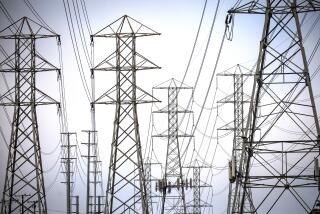Heat-Related Deaths Spur Call to Lower Power Rates
- Share via
PALM SPRINGS — First there was the death of 83-year-old Muree Foy. Three days later, David White, 47, who was asthmatic, was found dead in his home. A day after that, the Neill sisters were found, one dead, the other barely conscious.
The cause of all three deaths earlier this month was intense heat, authorities have found. Sweltering temperatures in the victims’ Palm Springs homes overtook them. All might have been saved if they had turned on air conditioners or gotten them repaired.
“We’ve had quite a few of these deaths this year,” said Palm Springs Police Sgt. Ron Starrs. “It’s unusual to have so many. But there are always people who just didn’t turn on their air-conditioning when they needed to.”
The deaths have spurred concern from state Sen. Jim Battin (R-La Quinta), who has long argued that electric companies should do more to provide affordable service to people living in the hottest regions of the state, where power bills routinely skyrocket during the summer months.
Expensive electricity in desert towns amounts to nothing less than a health hazard, Battin said.
“It’s common sense; it’s a no-brainer,” he said. “People are literally dying because they are so afraid to get [an electric] bill they can’t afford.” And yet the power companies “go out of their way to find reasons” not to provide more affordable rates.
On July 11, officers found Foy dead. A thermometer in the house registered 90 degrees, but officers said it felt much hotter. Foy had recently told friends that her air conditioner was broken and that she could not afford to get it fixed, police said.
On July 14, authorities were called to the home of White, whose father had discovered his son’s body in a chair in his bedroom. A thermometer hanging from the ceiling of the home read 109 degrees, according to police.
The father later told police that White, who was blind as well as asthmatic, was supposed to be napping after his noon meal.
The next day, July 15, neighbors called police to the home of two sisters after noticing newspapers piling up on their doorstep. Police entered the home just before 8 p.m. and found the temperature inside hovering around 110 degrees. The air conditioner was not on.
Police found 76-year-old Virginia Neill semi-conscious. She was rushed to a hospital and survived.
But her sister, Maggie Neill, 77, didn’t make it. She was found dead in her bed, sitting up against the headboard. Authorities said they found an electricity bill for about $25 in the Neills’ home.
That is “clearly indicative of someone who is just not using their air conditioner,” said Starrs, pointing out that neighbors report their own summertime electricity bills typically exceeding $100 a month.
Battin said such tragedies happen every year in the desert, particularly among elderly residents living on fixed incomes.
“They can’t afford the high rates,” said Kim Glassman, Battin’s chief of staff. “So instead, they suffer with no air conditioning, and we pay for it with heat-related deaths.”
Southern California Edison officials say they provide options for people, particularly those on limited incomes, in the heat of summer.
Residents living below the poverty line of about $22,600 a year for a two-person household are entitled to a 20% break on electricity rates, said Lynda Ziegler, director of customer programs and services.
Edison also accepts customer donations, distributed through the United Way, that help cover the bills of those in danger of having their electricity shut off.
During last year’s rolling blackouts, the utility set up cooling stations at various public places.
Edison also sends out brochures with information on heat exhaustion and tips such as escaping to a cool mall or movie theater, if possible. Battin says those efforts are not enough.
“I got news for the” Public Utilities Commission, Battin said. “People who live in the desert know about heat. Warning them to stay out of the sun just isn’t going to do anything.”
Cindra Rowell, Riverside County deputy director of public health, said it is unusual to have so many heat-related deaths within the space of a few days.
Rowell said people susceptible to heat exhaustion and heatstroke can begin to experience symptoms any time temperatures reach 100 degrees. General symptoms, she said, include weakness, dizziness, nausea and clammy skin. In more serious cases, the skin will feel hot and dry. The victim may get the chills and experience confusion.
“In serious cases, the person needs to get to a hospital to get
Battin took on the electricity companies last year with a measure forcing utilities to exclude the hottest regions from rolling blackouts. The situation was more critical then, he said, when California was grappling with an energy crisis.
The bill was signed into law last August but, so far, the utilities have not implemented plans for following the order, he said.
More to Read
Sign up for Essential California
The most important California stories and recommendations in your inbox every morning.
You may occasionally receive promotional content from the Los Angeles Times.













